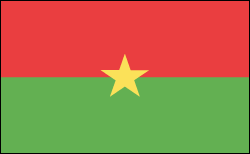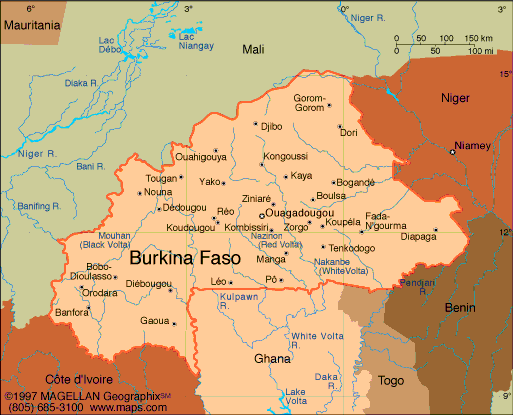BURKINA FASO

Geography: Slightly larger than Colorado, Burkina Faso, formerly known as Upper Volta, is a landlocked country in West Africa. Its neighbors are Côte d'Ivoire, Mali, Niger, Benin, Togo, and Ghana. The country consists of extensive plains, low hills, high savannas, and a desert area in the north.
Government: Parliamentary.
History: Burkina Faso was originally inhabited by the Bobo, Lobi, and Gurunsi peoples, with the Mossi and Gurma peoples immigrating to the region in the 14th century. The lands of the Mossi empire became a French protectorate in 1897, and by 1903 France had subjugated the other ethnic groups. Called Upper Volta by the French, it became a separate colony in 1919, was partitioned among Niger, the Sudan, and Côte d'Ivoire in 1932, and was reconstituted in 1947. An autonomous republic within the French Community, Upper Volta became independent on Aug. 5, 1960.
President Maurice Yameogo was deposed on Jan. 3, 1966, by a military coup led by Col. Sangoulé Lamizana, who dissolved the national assembly and suspended the constitution. Constitutional rule returned in 1978 with the election of an assembly and a presidential vote in June in which Gen. Lamizana won by a narrow margin over three other candidates.
On Nov. 25, 1980, Col. Sayé Zerbo led a bloodless coup that toppled Lamizana. In turn, Maj. Jean-Baptist Ouedraogo ousted Zerbo on Nov. 7, 1982. But the real revolutionary change occurred the following year when a 33-year-old flight commander, Thomas Sankara, took control. A Marxist-Leninist, he challenged the traditional Mossi chiefs, advocated women's liberation, and allied the country with North Korea, Libya, and Cuba. To sever ties to the colonial past, Sankara changed the name of the country in 1984 to Burkina Faso, which combines two of the nation's languages and means “the land of upright men.”
While Sankara's investments in schools, food production, and clinics brought some improvement in living standards, foreign investment declined, many businesses left the country, and unhappy labor unions began strikes. On Oct. 15, 1987, formerly loyal soldiers assassinated Sankara. His best friend and ally Blaise Compaoré became president. Compaoré immediately set about “rectifying” Sankara's revolution. In 1991, he agreed to economic reforms proposed by the World Bank. A new constitution paved the way for elections in 1991, which Compaoré won easily, although opposition parties boycotted. In 1998, he was reelected by a landslide. A coup against the president was foiled in 2003, and he was reelected a third time in 2005.
Prime Minister Yonli resigned in June 2007 and was replaced by Tertius Zongo, who has served as the ambassador to the United States and as the country's finance minister.
Violent protests by soldiers and police in the capital of Ouagadougou, sparked by low pay and unpaid housing allowances, were answered by President Blaise Compaore with a new government and a new head of the armed forces in the spring of 2011.
In Jan. 2013, Prime Minister Luc Adolphe Tiao's new government was announced; the main portfolios remain unchanged.
Government: Parliamentary.
History: Burkina Faso was originally inhabited by the Bobo, Lobi, and Gurunsi peoples, with the Mossi and Gurma peoples immigrating to the region in the 14th century. The lands of the Mossi empire became a French protectorate in 1897, and by 1903 France had subjugated the other ethnic groups. Called Upper Volta by the French, it became a separate colony in 1919, was partitioned among Niger, the Sudan, and Côte d'Ivoire in 1932, and was reconstituted in 1947. An autonomous republic within the French Community, Upper Volta became independent on Aug. 5, 1960.
President Maurice Yameogo was deposed on Jan. 3, 1966, by a military coup led by Col. Sangoulé Lamizana, who dissolved the national assembly and suspended the constitution. Constitutional rule returned in 1978 with the election of an assembly and a presidential vote in June in which Gen. Lamizana won by a narrow margin over three other candidates.
On Nov. 25, 1980, Col. Sayé Zerbo led a bloodless coup that toppled Lamizana. In turn, Maj. Jean-Baptist Ouedraogo ousted Zerbo on Nov. 7, 1982. But the real revolutionary change occurred the following year when a 33-year-old flight commander, Thomas Sankara, took control. A Marxist-Leninist, he challenged the traditional Mossi chiefs, advocated women's liberation, and allied the country with North Korea, Libya, and Cuba. To sever ties to the colonial past, Sankara changed the name of the country in 1984 to Burkina Faso, which combines two of the nation's languages and means “the land of upright men.”
While Sankara's investments in schools, food production, and clinics brought some improvement in living standards, foreign investment declined, many businesses left the country, and unhappy labor unions began strikes. On Oct. 15, 1987, formerly loyal soldiers assassinated Sankara. His best friend and ally Blaise Compaoré became president. Compaoré immediately set about “rectifying” Sankara's revolution. In 1991, he agreed to economic reforms proposed by the World Bank. A new constitution paved the way for elections in 1991, which Compaoré won easily, although opposition parties boycotted. In 1998, he was reelected by a landslide. A coup against the president was foiled in 2003, and he was reelected a third time in 2005.
Prime Minister Yonli resigned in June 2007 and was replaced by Tertius Zongo, who has served as the ambassador to the United States and as the country's finance minister.
Violent protests by soldiers and police in the capital of Ouagadougou, sparked by low pay and unpaid housing allowances, were answered by President Blaise Compaore with a new government and a new head of the armed forces in the spring of 2011.
In Jan. 2013, Prime Minister Luc Adolphe Tiao's new government was announced; the main portfolios remain unchanged.

Map of Burkina
Faso
President: Michel Kafando
(2014; interim)
Prime Minister: Lt. Col. Isaac Zida
(2014; interim)
Land area: 105,714 sq mi (273,799 sq km);
total area: 105,869 sq mi (274,200 sq km)
Population (2014 est.): 18,365,123
(growth rate: 3.05%); birth rate: 42.42/1000; infant mortality rate:
76.8/1000; life expectancy: 54.78
Capital and largest city (2011 est.):
Ouagadougou, 2.053 million
Monetary unit: CFA Franc
Ethnicity/race:
Mossi (over 40%), Gurunsi, Senufo, Lobi, Bobo,
Mande, Fulani
National Holiday:
Republic Day, December 11
Religions:
Muslim 60.5%, Catholic 19%, animist 15.3%, Protestant 4.2%, other 0.6%, none 0.4% (2006 est.)
Literacy rate: 28.7% (2007 est.)
Economic summary: GDP/PPP (2013
est.): $26.51 billion; per capita $1,500. Real growth rate:
6.5%. Inflation: 2.1%. Unemployment: 77%
Arable land: 20.79%. Agriculture: cotton, peanuts, shea
nuts, sesame, sorghum, millet, corn, rice; livestock. Labor
force: 6.668 million; note: a large part of the male labor force
migrates annually to neighboring countries for seasonal employment
(2003); agriculture 90%, industry and services 10% (2000 est.).
Industries: cotton lint, beverages, agricultural processing,
soap, cigarettes, textiles, gold. Natural resources:
manganese, limestone, marble; small deposits of gold, phosphates,
pumice, salt. Exports: $2.844 billion (2013 est.):
cotton, livestock, gold. Imports: $2.941 billion (2013
est.): capital goods, food products, petroleum. Major trading
partners: China, Ghana, France,
Côte d'Ivoire, Togo, Turkey, Belgium (2012).
Communications: Telephones: main lines
in use: 141,000 (2012); mobile cellular: 9.98 million (2012). Broadcast media:
2 TV stations - 1 state-owned and 1 privately owned; state-owned radio
runs a national and regional network; substantial number of privately
owned radio stations; transmissions of several international
broadcasters available in Ouagadougou (2007). Internet
hosts: 1,795 (2012). Internet users: 178,100 (2009).
Transportation: Railways: total: 622 km
(2008). Roadways: total: 15,272 km (2010). Ports and harbors: none.
Airports: 23 (2013 est.).
International disputes:
adding to illicit cross-border activities, Burkina Faso has issues
concerning unresolved boundary alignments with its neighbors;
demarcation is currently underway with Mali, the dispute with Niger was
referred to the ICJ in 2010, and a dispute over several villages with
Benin persists; Benin retains a border dispute with Burkina Faso around
the town of Koualou.
-------------------- o --------------------
No comments:
Post a Comment